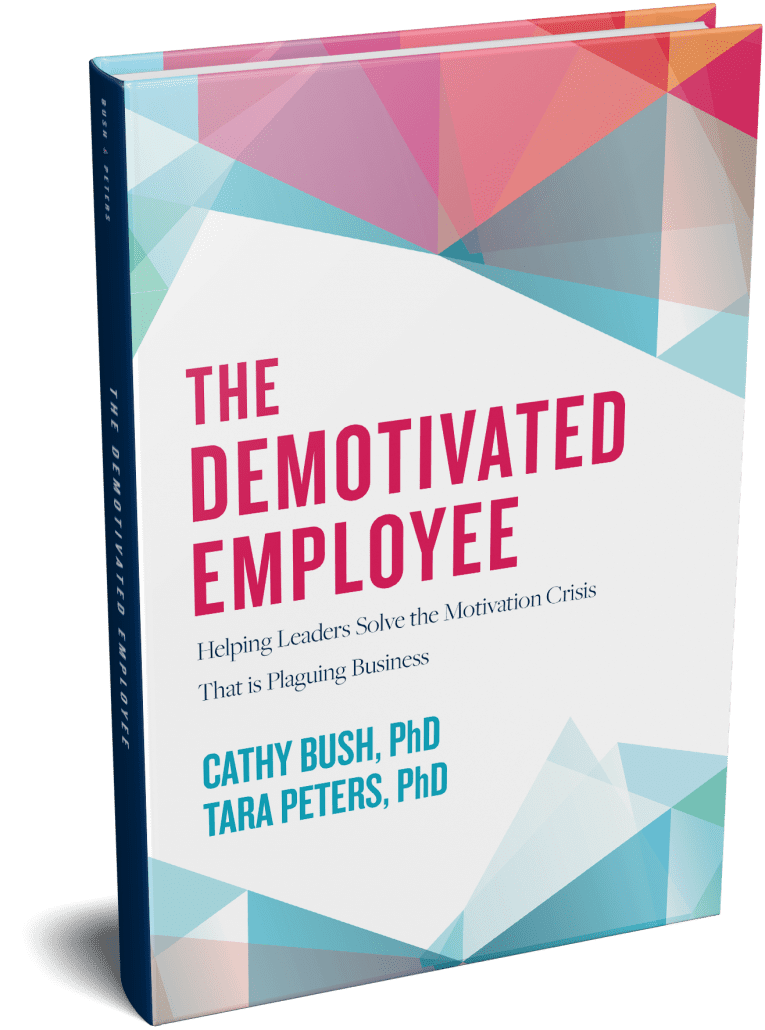The Demotivated Employee: What Causes Employees to Lose Their Motivation?

It’s likely that you can relate because most of us, at some point in our careers, have had this happen to us. In fact, my colleague, Dr. Cathy Bush and I, have heard lots of stories from MBA students describing similar situations in their professional lives. Because we’ve heard these stories so much, we decided to do some digging to figure out what was causing employees, who were once highly driven and committed to the work, to lose their motivation. And what we discovered were five sources of demotivation or factors that contributed to employees losing their motivation. However, not only did we identify the sources, but we also pinpointed behaviors that leaders can execute to prevent demotivation from occurring in the first place. Or, if it does happen, to help repair the damage that’s been done and to help employees regain their “motivation mojo.”
So, here are the five sources of demotivation and what leaders can do.
- Individual differences. Your personality, attitude and competence play a role in keeping you motivated. For instance, when we work in positions that are suited to our personality preferences, we’re more likely to keep the motivation that we brought to the work and to contribute in meaningful ways. Or when we’re feeling good about our ability to complete tasks or to perform well in our job, we’re more likely to be motivated. While this source is primarily attributable to the individual, it doesn’t mean the manager doesn’t have a role to play too. Because of the pandemic, employees may have new responsibilities and find themselves in situations where they may not be prepared or have the necessary skills. It’s important for managers to pay attention and help their employees to “get up to speed.” The sooner you do this, the sooner your employees can gain the necessary competence and confidence to perform their new tasks successfully and fulfill their job responsibilities.
- Stress. It will come as no surprise that stressful work conditions can cause employees to burn out and dread going to work. While stress can give us short-term boosts to meet deadlines, it can become debilitating, adversely affecting our health and well-being, when it returns frequently or lasts for long periods of time. How leaders respond during times of stress is critical. Given the sudden changes and uncertainty that have occurred as a result of the pandemic, employees are stressed. So, as a manager, research the top tips to avoid burnout at work and take the time to have a one-on-one conversation with your employees to talk about how their adjusting to the new changes and to see what’s working and what’s not. This will give you the opportunity not only to listen and to empathize, but to work with the employee to address stressors the individual is dealing with.
- Organizational culture. Culture is a big deal. The significance of culture is rooted in the fact that it consists of core values that permeate every part of the organization from norms to decision making. People often choose to work for an organization because the culture “fits” their preferences for how they want to work. Kim Cameron and Robert Quinn (2011) have identified four cultures that are indicative of most organizations: clan, adhocracy, hierarchy and market. Each of these cultures has a unique set of values that influence multiple facets of the organization from the flow of information to how firms integrate standardized processes and procedures. If there’s a “mismatch” between the organizational culture and how an employee prefers to work, there’s a chance the employee will no longer be motivated. So, leaders should pay attention to how social distancing and remote work are affecting their culture. For example, adhocracy cultures are characterized by lots of collaboration and teamwork in order to drive innovation in the marketplace. Replicating those values in your new “virtual” culture will be important, so employees continue to work in ways that are congruent with the values that caused them to choose your company.
- Conflict with co-workers.Conflict is going to happen. It’s inevitable. When you bring together people from diverse backgrounds, with different ideas, agendas and experiences, you’re going to have conflict. So, don’t be afraid of it. Conflict, if it’s managed well, can be healthy for the organization. How so? Well, when conflict surfaces because employees have different ideas about how to roll out a new product, as an example, this can be a good thing for the organization. Why? Because the manager can use this opportunity to create a hearty debate that allows employees to really “drill down” on which idea makes the most sense based upon data. This can result in the company achieving a better outcome than if everyone simply agreed upon everything from the outset. Being able to do this in a way that doesn’t result in hurt feelings and winners and losers, will require leaders to create the cultural conditions that allow employees to see conflict as something to be embraced, rather than something to be avoided.
- Leadership Styles. We’ve heard the saying, “people quit their bosses, not their jobs.” How leaders behave when managing their folks has a profound impact on employees. When managers show that they trust employees and allow them to give input to decisions, they create an environment where employees feel valued and are more likely to be committed. However, when leaders fail to keep employees informed with timely and relevant information, or don’t ask for their input on decisions or ignore obstacles that are getting in the way, employees will lose their motivation over time. Because these “failures” adversely affect employee engagement and motivation, leaders should pay special attention to them during this time of crisis. Given all of the uncertainty and angst about how the virus may affect the business and jobs, managers must ensure that communication is honest and ongoing. Employees can handle the truth. It’s important that you tell them. Keeping employees informed about what’s going on, removing obstacles that are getting in the way of their remote work and soliciting their input, where appropriate, can go a long way towards helping employees to maintain their motivation, in spite of the difficult circumstances.
- Lack of success. Everyone needs a little bit of success at work. It’s necessary for feeling like you’re making a contribution and doing a good job. A lack of success, however, is often a sign to employees that they need to move on – and that can be bad for business. So what can you do? Well, it depends on the areas in which your employees are struggling. If they’re finding it difficult to convert leads, then sales coaching techniques could help. Likewise, if they’re struggling to master their current position, then they may require professional development. Small acts of generosity on your part can make a tremendous difference in both how they approach their work and their productivity level.
Imagine if we lived in a “work world” where employees woke up every day excited to go to the office? It may sound like “pie in the sky,” but actually it’s not. If it were, then we wouldn’t have the Fortune 100 Best Companies to Work For™ list. By attending to the five sources of demotivation, leaders can create workplaces where employees are highly motivated and engaged. So, in the words of the great philosopher, Yoda, “Do. Or do not. There is no try.” Let’s stop causing employees to be demotivated, and instead, behave in ways that cause them to keep their “motivation mojo.”
About the Author


 In today’s modern world, words like “leadership” and “optimization” can feel a bit like cheap buzz words that are thrown around casually at business seminars.
In today’s modern world, words like “leadership” and “optimization” can feel a bit like cheap buzz words that are thrown around casually at business seminars. When you’re forced to shift the operations of your business to a completely remote format for your workers, as many companies have been recently, you might not know exactly where to begin. Most business owners won’t have planned for a situation where none of their employees are permitted to be present at the business’s physical location.
When you’re forced to shift the operations of your business to a completely remote format for your workers, as many companies have been recently, you might not know exactly where to begin. Most business owners won’t have planned for a situation where none of their employees are permitted to be present at the business’s physical location. In theory,
In theory, 

